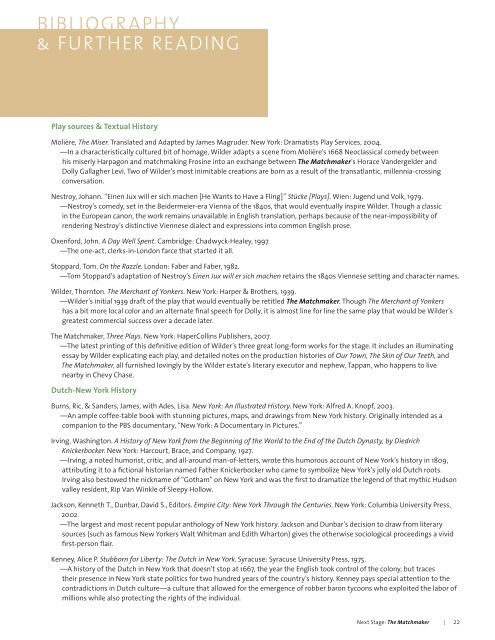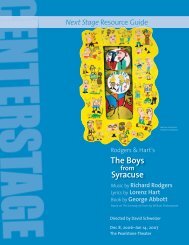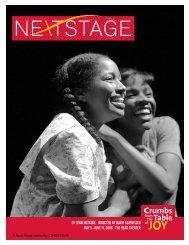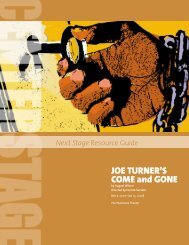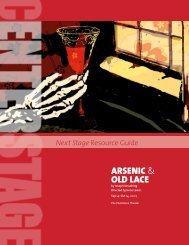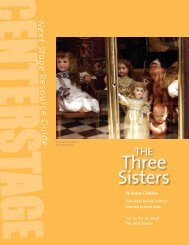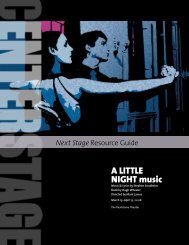The Matchmaker - Center Stage
The Matchmaker - Center Stage
The Matchmaker - Center Stage
You also want an ePaper? Increase the reach of your titles
YUMPU automatically turns print PDFs into web optimized ePapers that Google loves.
BiBlioGr aphy<br />
& Further readinG<br />
Play sources & textual History<br />
Molière, <strong>The</strong> Miser. Translated and Adapted by James Magruder. New York: Dramatists Play Services, 2004.<br />
—In a characteristically cultured bit of homage, Wilder adapts a scene from Molière’s 1668 Neoclassical comedy between<br />
his miserly Harpagon and matchmaking Frosine into an exchange between <strong>The</strong> <strong>Matchmaker</strong>’s Horace Vandergelder and<br />
Dolly Gallagher Levi. Two of Wilder’s most inimitable creations are born as a result of the transatlantic, millennia-crossing<br />
conversation.<br />
Nestroy, Johann. “Einen Jux will er sich machen [He Wants to Have a Fling]” Stücke [Plays]. Wien: Jugend und Volk, 1979.<br />
—Nestroy’s comedy, set in the Beidermeier-era Vienna of the 1840s, that would eventually inspire Wilder. Though a classic<br />
in the European canon, the work remains unavailable in English translation, perhaps because of the near-impossibility of<br />
rendering Nestroy’s distinctive Viennese dialect and expressions into common English prose.<br />
Oxenford, John. A Day Well Spent. Cambridge: Chadwyck-Healey, 1997.<br />
—<strong>The</strong> one-act, clerks-in-London farce that started it all.<br />
Stoppard, Tom. On the Razzle. London: Faber and Faber, 1982.<br />
—Tom Stoppard’s adaptation of Nestroy’s Einen Jux will er sich machen retains the 1840s Viennese setting and character names.<br />
Wilder, Thornton. <strong>The</strong> Merchant of Yonkers. New York: Harper & Brothers, 1939.<br />
—Wilder’s initial 1939 draft of the play that would eventually be retitled <strong>The</strong> <strong>Matchmaker</strong>. Though <strong>The</strong> Merchant of Yonkers<br />
has a bit more local color and an alternate final speech for Dolly, it is almost line for line the same play that would be Wilder’s<br />
greatest commercial success over a decade later.<br />
<strong>The</strong> <strong>Matchmaker</strong>, Three Plays. New York: HaperCollins Publishers, 2007.<br />
—<strong>The</strong> latest printing of this definitive edition of Wilder’s three great long-form works for the stage. It includes an illuminating<br />
essay by Wilder explicating each play, and detailed notes on the production histories of Our Town, <strong>The</strong> Skin of Our Teeth, and<br />
<strong>The</strong> <strong>Matchmaker</strong>, all furnished lovingly by the Wilder estate’s literary executor and nephew, Tappan, who happens to live<br />
nearby in Chevy Chase.<br />
Dutch-new york History<br />
Burns, Ric, & Sanders, James, with Ades, Lisa. New York: An Illustrated History. New York: Alfred A. Knopf, 2003.<br />
—An ample coffee-table book with stunning pictures, maps, and drawings from New York history. Originally intended as a<br />
companion to the PBS documentary, “New York: A Documentary in Pictures.”<br />
Irving, Washington. A History of New York from the Beginning of the World to the End of the Dutch Dynasty, by Diedrich<br />
Knickerbocker. New York: Harcourt, Brace, and Company, 1927.<br />
—Irving, a noted humorist, critic, and all-around man-of-letters, wrote this humorous account of New York’s history in 1809,<br />
attributing it to a fictional historian named Father Knickerbocker who came to symbolize New York’s jolly old Dutch roots.<br />
Irving also bestowed the nickname of “Gotham” on New York and was the first to dramatize the legend of that mythic Hudson<br />
valley resident, Rip Van Winkle of Sleepy Hollow.<br />
Jackson, Kenneth T., Dunbar, David S., Editors. Empire City: New York Through the Centuries. New York: Columbia University Press,<br />
2002.<br />
—<strong>The</strong> largest and most recent popular anthology of New York history. Jackson and Dunbar’s decision to draw from literary<br />
sources (such as famous New Yorkers Walt Whitman and Edith Wharton) gives the otherwise sociological proceedings a vivid<br />
first-person flair.<br />
Kenney, Alice P. Stubborn for Liberty: <strong>The</strong> Dutch in New York. Syracuse: Syracuse University Press, 1975.<br />
—A history of the Dutch in New York that doesn’t stop at 1667, the year the English took control of the colony, but traces<br />
their presence in New York state politics for two hundred years of the country’s history. Kenney pays special attention to the<br />
contradictions in Dutch culture—a culture that allowed for the emergence of robber baron tycoons who exploited the labor of<br />
millions while also protecting the rights of the individual.<br />
Next <strong>Stage</strong>: <strong>The</strong> <strong>Matchmaker</strong> |


